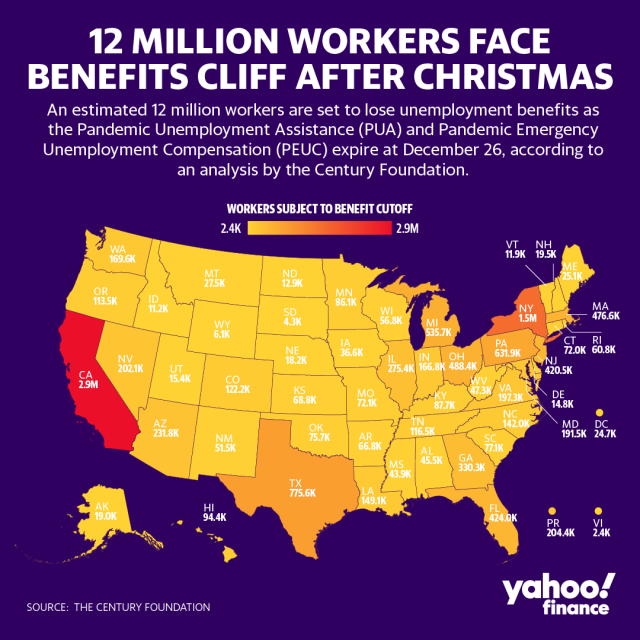'Pretty grim picture' for economy after Christmas without new COVID-19 stimulus
A $908 billion proposal from Congress may be the only lifeline for millions of Americans set to lose their pandemic unemployment support after Christmas.
The bipartisan proposal unveiled earlier this week would include an extra $300 in weekly unemployment benefits, in addition to an extension of Pandemic Unemployment Assistance (PUA) to April 1 and Pandemic Emergency Unemployment Compensation (PEUC) to January 31.
Failure to pass something may mean no stimulus until after inauguration, which would amount to at least a month’s gap of no benefits.
“Stimulus is certainly needed to stabilize our economy, both unemployed workers, small businesses, and larger sectors of the economy,” Elizabeth Pancotti, a policy adviser at Employ America, told Yahoo Finance Live. Pancotti co-authored with Andrew Stettner a report from The Century Foundation that estimates about 12 million people will no longer be able to access PUA and PEUC when it expires on December 26.
“The risk here is pretty clear,” she added.

PUA covers those not eligible for traditional unemployment benefits, such as gig and contract workers. PEUC, meanwhile, offers an additional 13 weeks of payments if an unemployed person exhausted their 26 weeks of regular state benefits. When the $600-per-week bonus unemployment insurance expired in the summer, the unemployed were still able to tap PUA and standard state benefits.
But once PUA expires, gig and contract workers, for example, would have nowhere to turn. With businesses facing new lockdown restrictions or going bust entirely, the lack of income would leave these workers without a lifeline.
“Having some income versus no income is a really big difference,” said Pancotti, adding that the loss of benefits could lead to slower economic activity in the form of lower consumer spending, for an example.
The Economic Policy Institute (EPI) estimated December 2 that 5.1 million more jobs would be created if the government kept open the suite of pandemic unemployment insurance programs in 2021, including the extra $600-per-week benefit.
‘Pretty grim picture’
PUA and PEUC were both authorized by the Coronavirus Aid, Relief, and Economic Security (CARES) Act in March, but with year-end termination dates on the assumption that the country would have been past COVID-19 by that time.
Instead, the U.S. is heading into the new year with the amount of new daily cases rising to record highs and 9.8 million fewer Americans on payroll compared to pre-pandemic levels.
Other critical support measures, such as federal moratoria on evictions and student debt, are also set to expire at the end of December.
“Given the combination of all of those things, it seems like a pretty grim picture for the American economy in the coming months,” Pancotti said.
The Century Foundation estimates that 7.3 million workers will see their PUA benefits expire, with 4.6 million to see their PEUC benefits prematurely end.
Pancotti and the EPI have advocated for pinning the availability of unemployment insurance programs to economic conditions. The so-called “automatic stabilizers” would, for example, keep the programs open until employment returns to a certain level.
The $908 billion proposal does not include such a structure.
Brian Cheung is a reporter covering the Fed, economics, and banking for Yahoo Finance. You can follow him on Twitter @bcheungz.
Fed officials call for keeping emergency loans available past Mnuchin's Dec. 31 expiry date
Congress grabs reins from Fed and Treasury on emergency loan programs
What a Treasury Secretary Janet Yellen would mean for markets
Less-educated Asian Americans among hardest hit by job losses during pandemic
A glossary of the Federal Reserve's full arsenal of 'bazookas'
Read the latest financial and business news from Yahoo Finance
Follow Yahoo Finance on Twitter, Facebook, Instagram, Flipboard, SmartNews, LinkedIn, YouTube, and reddit.

 money
money 
